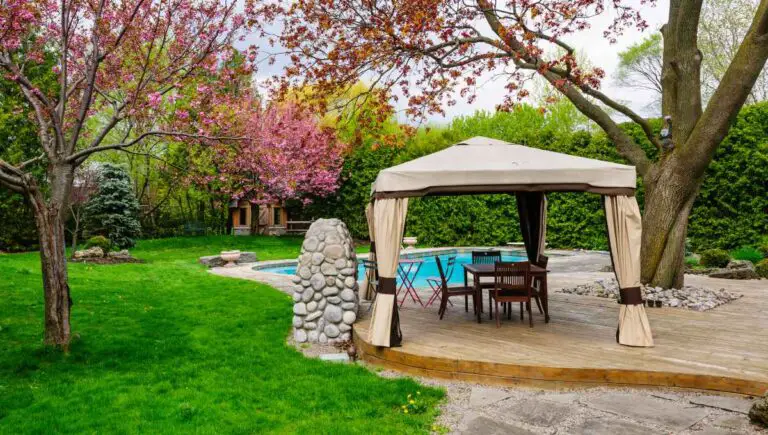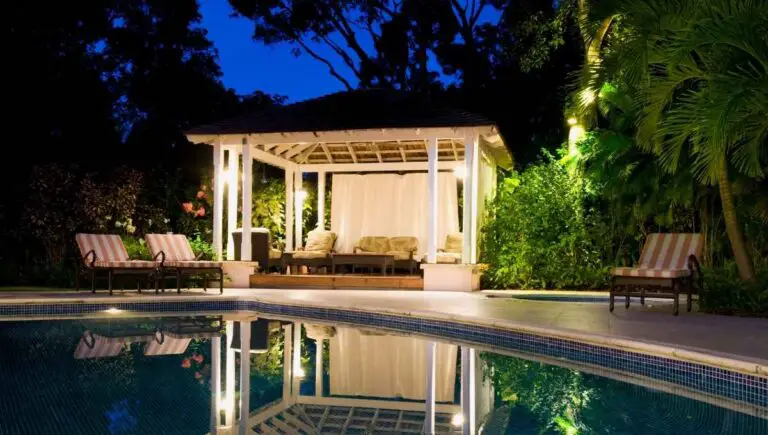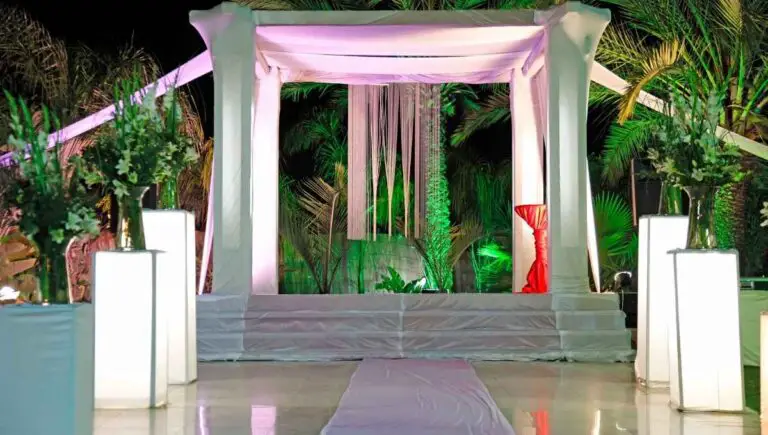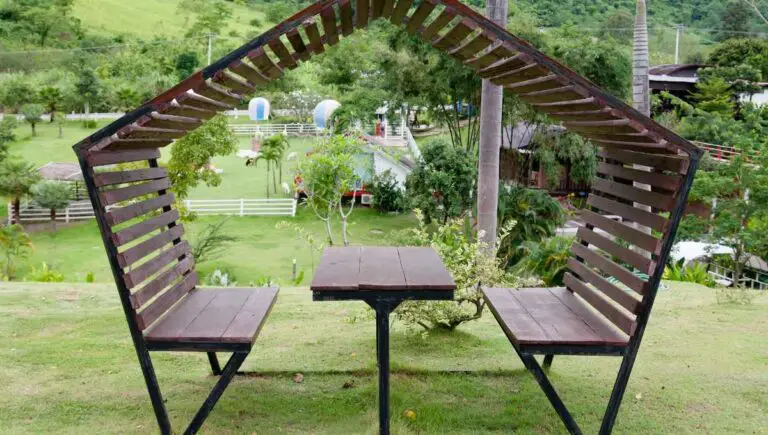Do Gazebos Need Gutters? (Protecting Your Gazebo From Rain)
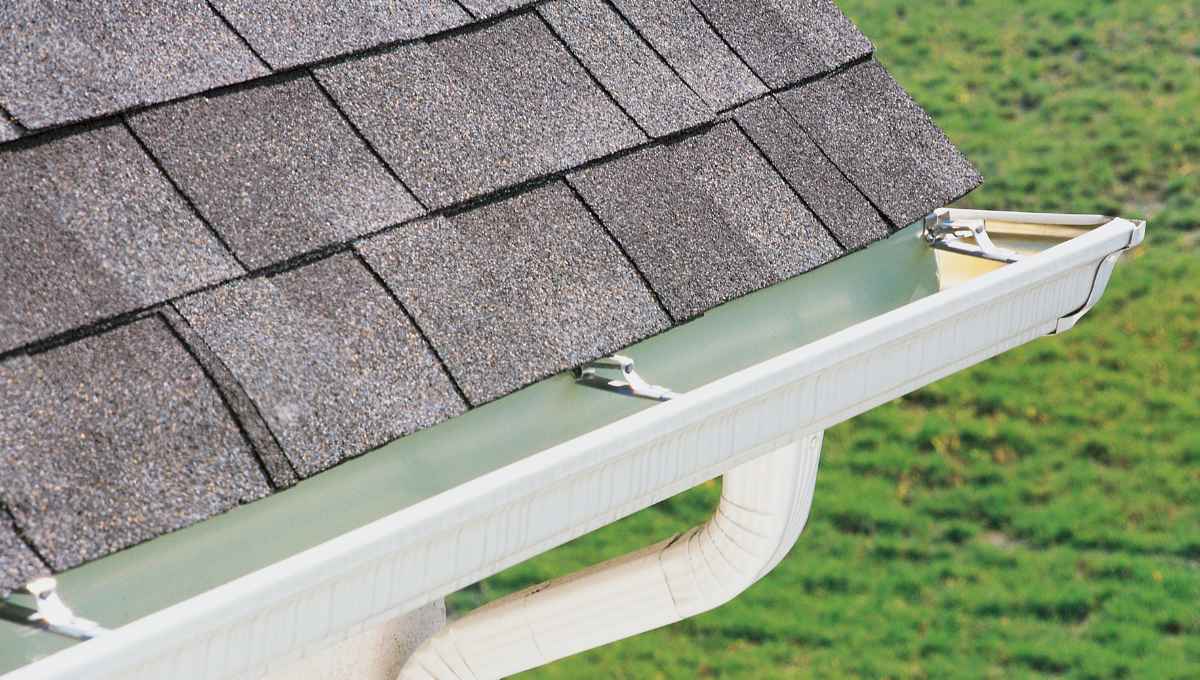
If you’re building a gazebo, it takes a lot of planning and preparation. However, something that you might not think about is gutters. Do gazebos need gutters in the first place? Well, the answer might surprise you.
Gazebos do not necessarily need gutters, but they will significantly benefit the homeowner once installed. The gutters transport the rainwater to another location instead of dumping all the rainwater next to your gazebo.
Gazebo gutters can even be vital if you live in an area with large yearly rainfall measurements. In this article, we look at the benefits of gutters and other methods to waterproof and protect your gazebo.
This post contains affiliate links from Amazon and other stores. This means Yard Blogger may earn a commission if you make a purchase using any of our links. Please refer to our full affiliate disclosure policy for full details.
Here’s a Quick Pro Tip!
Environmental factors such as the weather are often forgotten when building a gazebo. This could be a grave error once the first rain approaches and you realize your gazebo is ill-equipped.
The top products to secure your gazebo against rainfall and storms:
1. Gutters– ideal for capturing rainwater and transporting it to the drain.
2. Tarp– can be used to cover your gazebo during a rainstorm.
3. Gazebo Weights – perfect for adding extra weight to your gazebo.
Gazebo Gutters
Most gazebos are not designed or built with gutters, but you can add your own in a later project. It’s relatively straightforward to attach gutters to your gazebo, and this is an effective way to collect and remove all the rainwater.
The Purpose of Gazebo Gutters
If your gazebo roof is sloped, the rainwater rolls off the roof and onto whatever is underneath the roof. This could create flooding or an excess of water where it is not wanted. Thus, it’s a good idea to add gutters to your sloped gazebo.
Gutters collect the water from the roof and use pipes to lead the water to a different location. This could be a storage tank or simply back into the sewer system, whichever you desire.
Gazebos and Rain
Pop-up gazebos are not designed to withstand harsh rains, maybe a light drizzle. If the weatherman forecasts a rainstorm, consider taking your pop-up gazebo down.
A permanent gazebo, on the other hand, is designed to withstand rain. These wooden, vinyl or steel gazebos are built with a roof to provide shade and dryness underneath.
If you have heavy rainfall in your area, consider adding gutters to your gazebo to transport the rainwater into the sewage system.
You might also enjoy our post on Whether Gazebos Are Safe in Lightning
Rainwater Pooling On Your Gazebo
If you have a flat roof on your gazebo, you might think that rainwater pooling on your roof is normal, but according to the National Roofing Contractors Association (PDF Guide) – you should have your roof checked.
If rain is pooling on your roof for more than two days, it could indicate that the roof does not meet specific building standards. Even though it’s called a flat roof, it still needs to have a slight slope, allowing rain and snow to flow off of the roof and prevent pooling.
If your permanent gazebo has a pooling issue, you should contact a professional roofing contractor to inspect and evaluate your roof.
If you have a pop-up gazebo with a flat canvas canopy, you can plant a pole that is slightly higher than the canopy in the middle of the gazebo.
This will create a slope and allow all the pooling water to roll off the canopy. You can also use a waterproof spray on your canvas canopy to encourage the water to roll off the roof.
Waterproofing Tips and Tricks
Permanent gazebo structures are designed to be waterproof, although extra precautions can never hurt. If your gazebo is made of wood, consider painting an outdoor sealant over the wood to protect the wood against water and weather damage.
You can also throw a gazebo tarp over the structure if a lot of rain is forecasted. You will still be able to sit underneath the gazebo and enjoy the sound of the rain, but you won’t have to worry about getting wet in the rain.
A tarp will also work for a temporary gazebo; if the canvas canopy is not waterproof, a tarp will do the job.
Gazebo vs. Storm
Permanent gazebo structures are designed to withstand most storms (if they are built according to building codes), so you should be safe underneath one. However, pop-up gazebos are not as sturdy.
Here are a few ways to reinforce your gazebo in a storm:
- Throw a tarp over the gazebo and secure it with straps.
- Gazebo weights add extra weight to contradict strong winds.
- Ratchet straps are ideal for tying down your gazebo in high winds.
- A waterproof spray can be used to protect your canopy from heavy rainfall (also make sure your canopy is sloped).
Ideal Roofing
The most common type of roofing for gazebos is shingles. This is because they are easy to install and much more durable than other roofing materials.
In most cases, the builder will try to match the roofing of your gazebo to the roofing of your house to create a sense of coherence, although this is not required by law.
Shingles also offer the best protection against the elements, including the sun and rainfall. It’s designed to force rainwater to roll off the roof and into the gutters.
Shingle roofs also don’t leak often, but when they do, it’s easy to repair.
You might also enjoy our post on Whether a Gazebo is Safe in Wind
Final Thoughts
A gazebo does not need gutters according to building codes, but we would highly recommend adding gutters to your permanent garden structure.
The benefits and assurance that the rainwater is transported away outweigh the downsides – if there are any!




